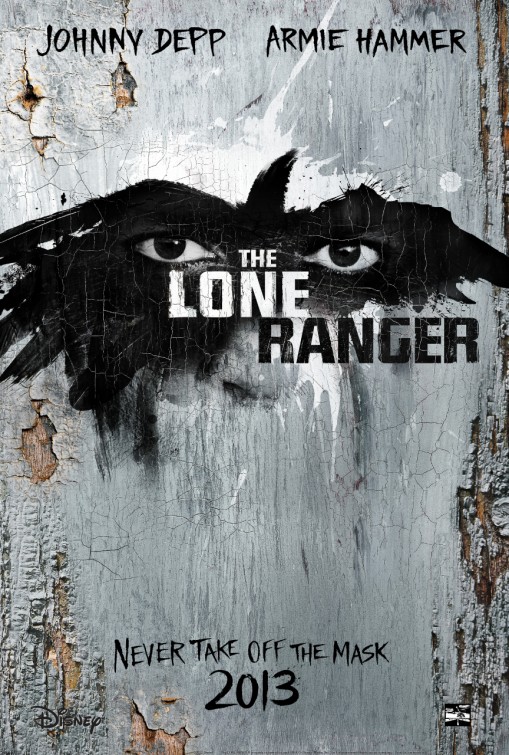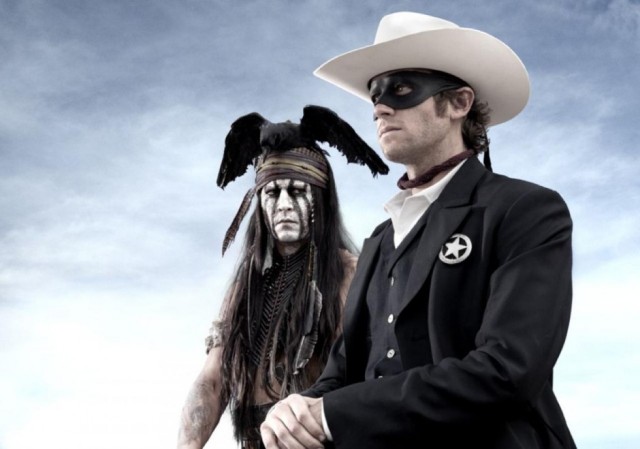

“The Lone Ranger” opens in
San Francisco in 1933. A little boy in a
cowboy outfit, hat, vest, mask, and matching cap pistols pays for a ticket to
see a Wild West Show. He stares at a
number of exhibits, such as the buffalo, and then he meets a replica of a Noble
Savage. At this point, in the tradition
of the “Night at the Museum,” the Indian surprises him and speaks. A wizened Tonto (Johnny Depp of “Blow”) wears
a black bird atop his head and looks like he should be at the Happy Hunting
Ground. He recognizes his old partner,
the Lone Ranger, and blows the little guy’s mind so much that the kid whips out
a cap pistol and blasts away. Afterward,
Tonto settles down to chronicle the legend of the Lone Ranger. John Reid (Armie Hammer of “The Social
Network”) has acquired a law degree and is returning home to Colby, Texas, to
serve as the county prosecutor. At the
same time, treacherous railroad executive Lathan Cole (Tom Wilkerson of “The
Green Hornet”) has pulled strings so he can hang one of the most notorious
outlaws, Butch Cavendish (William Fichtner of “Heat”), wherever he wants as a
warning to other desperadoes. Awaiting
the train at the station is John’s older brother Dan (James Badge Dale of
“World War Z”). John and Dan’s father
served with the Texas Rangers. Dan and
his wife Rebecca (Ruth Wilson) watch in horror as the train derails. A huge lever
designed to spin the wheels of the locomotive tumbles end-over-end from the sky
and narrowly misses our heroes. When we
meet the chief villain, Butch Cavendish, this murderer is chained to the floor
of a freight car. Tonto sits nearby and
watches as the outlaw finds a six-gun stashed under a plank. Cavendish behaves like an unsavory villain. He shoots both of sentries without a
qualm. Impetuous John Reid manages to
get the drop on him. Nevertheless,
Cavendish escapes, and our heroes barely get off the train in time to save
themselves. Dan forms a posse and tosses
John his father’s Texas Rangers badge.
Basically, John behaves like every western tinhorn that you’ve ever seen
on the big-screen. Dan’s trustworthy
scout Collins (Leon Rippy of “Stargate”) betrays the Rangers and leads them
into an ambush. Everybody gets shot to
ribbons. The depraved Cavendish turns
out to be a cannibal, but he isn’t shown chowing down. Meantime, John is shot
twice, passes out, and appears dead for all practical purposes. Tonto finds him later and tries to bury him. At one point, a mysterious white stallion materializes
and scrapes its hoof across John Reid’s Ranger badge. Afterward, Cavendish kidnaps Dan’s widow
Rebecca and her son Danny. Eventually,
Cavendish orders Collins to finish them off.


“The Lone Ranger” occurs
against the scenic backdrop of American history during the construction of the
transcontinental railroad. The infamous Cavendish
and Cole are playing for high stakes.
They have struck it rich with silver mine and excavated over $30 million
worth of ore. Rather than remain content
as a minor railway executive, Cole mounts a hostile takeover of the railway company
while orchestrating the annihilation of the Comanche Indian nation. John Reid bumbles along for the first 90
minutes trying to convince himself he can be a man of action. Verbinski pulls out all stops late in this
149 minute melodrama when he stages a chase between two trains. This incredible railway sequence is
reminiscent of the unforgettable stunts that silent movie star Buster Keaton pulled
off in “The General.” Finally, near the
end of the movie, John Reid understands why he must never remove the mask. He also realizes why he can never have a
relationship with Rebecca. As corrupt as society is, the only way to combat
this corruption is to be an outlaw.
Altogether, despite its titanic length, “The Lone Ranger” has no
shortage of death-defying exploits or spectacular desert scenery.






